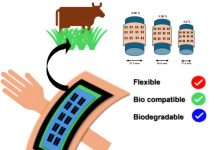
In a groundbreaking development, scientists from Penn State University have introduced an innovative device that could transform how medical implants, like pacemakers and insulin pumps, are powered.
This new technology harnesses energy from both magnetic fields and ultrasound simultaneously, providing a safe and efficient way to power implants within the human body.
Implantable medical devices are becoming increasingly sophisticated, shrinking in size while incorporating wireless capabilities.
However, powering these tiny, next-generation devices without wires has been a significant challenge.
The Penn State team’s invention addresses this issue head-on, presenting a solution that could power implants more effectively and safely than ever before.
Published in the journal Energy & Environmental Science, the researchers unveiled the first device of its kind to efficiently gather energy from two different sources at once, all while ensuring the safety of human tissue.
This dual-energy harvesting approach marks a significant leap forward, offering 300% more power compared to existing technologies.
Bed Poudel, a research professor in the Department of Materials Science and Engineering at Penn State and a co-author of the study, emphasized the device’s potential to unlock new possibilities in biomedical applications. By integrating magnetic and ultrasound energy harvesting, the device can significantly increase the power output from a compact form, paving the way for advancements that were previously out of reach.
This technology could lead to the development of battery-free bioelectronic devices that are small enough to be easily implanted into the body. These devices could form networks of sensors and actuators, enabling precise monitoring and manipulation of physiological functions. Such capabilities would allow for targeted and adaptive treatments with minimal impact on patients’ daily lives.
Traditional implants, such as pacemakers, rely on batteries that may require surgical replacement, carrying risks of infection and other complications. Wireless charging offers a promising alternative, potentially extending the lifespan of these implants. However, as implants become smaller, the efficiency of traditional wireless charging technologies decreases.
Mehdi Kiani, an associate professor of electrical engineering at Penn State and another co-author, highlighted the limitations of conventional wireless charging methods for miniaturized implants. The high frequencies used in standard wireless charging can pose health risks, making lower-frequency magnetic and ultrasound energy more appealing for this application.
Prior research has focused on devices that can harvest energy from either magnetic fields or ultrasound, but not both simultaneously. This single-source approach often falls short in providing sufficient power for smaller implants. The Penn State team’s device, however, can harvest energy from both sources at once, significantly increasing the available power.
Sumanta Kumar Karan, a postdoctoral scholar and the study’s lead author, explained that combining two energy modalities in one receiver multiplies the power output, greatly enhancing the device’s effectiveness.
This innovative device represents a major stride towards safer, more efficient power solutions for wireless medical implants. It holds the promise of advancing healthcare technology, offering new possibilities for patient care without the limitations of current power sources.



